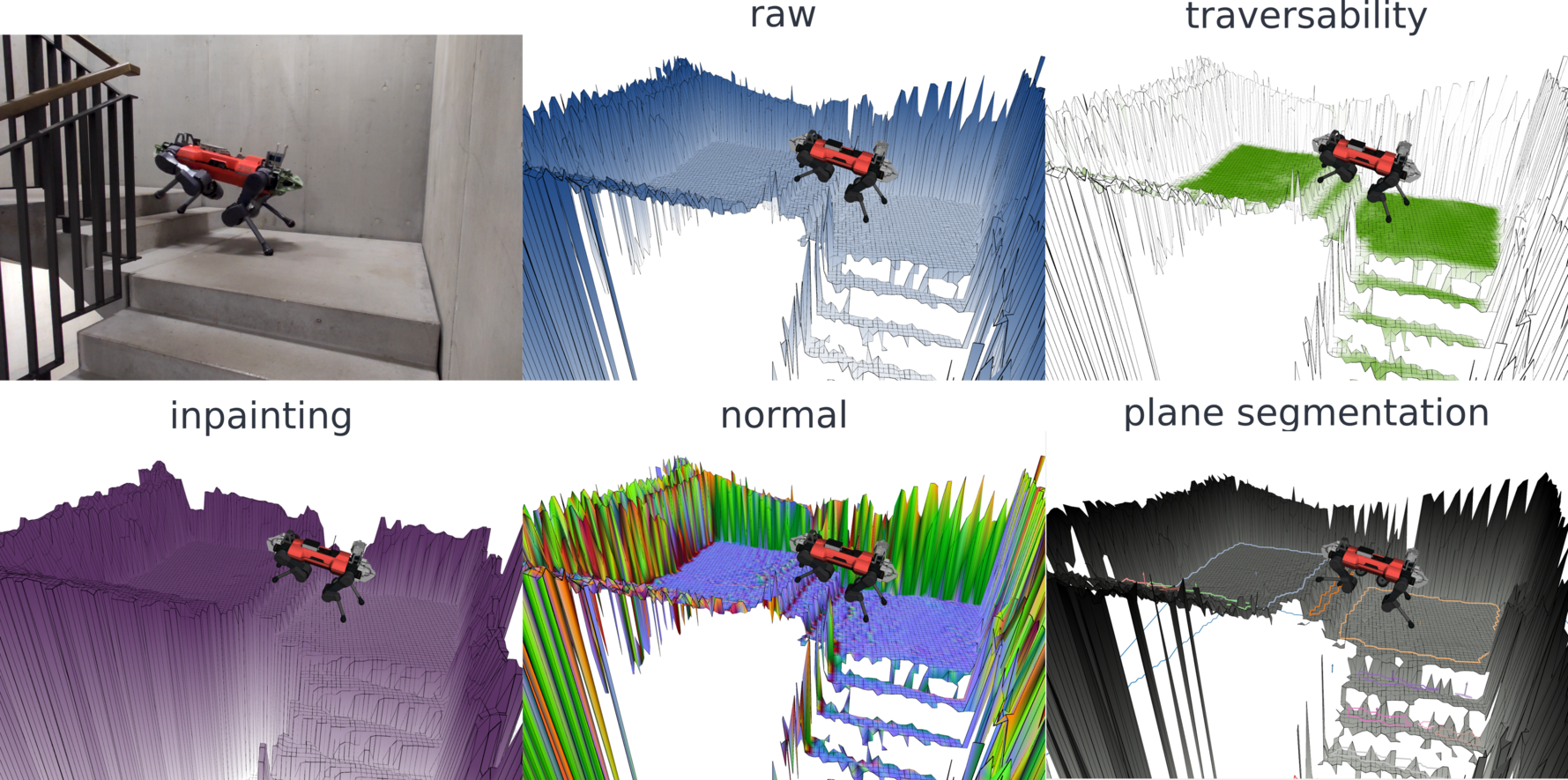The Elevaton Mapping CuPy software package represents an advancement in robotic navigation and locomotion.
Integrating with the Robot Operating System (ROS) and utilizing GPU acceleration, this framework enhances point cloud registration and ray casting,
crucial for efficient and accurate robotic movement, particularly in legged robots.



-
Height Drift Compensation: Tackles state estimation drifts that can create mapping artifacts, ensuring more accurate terrain representation.
-
Visibility Cleanup and Artifact Removal: Raycasting methods and an exclusion zone feature are designed to remove virtual artifacts and correctly interpret overhanging obstacles, preventing misidentification as walls.
-
Learning-based Traversability Filter: Assesses terrain traversability using local geometry, improving path planning and navigation.
-
Versatile Locomotion Tools: Incorporates smoothing filters and plane segmentation, optimizing movement across various terrains.
-
Multi-Modal Elevation Map (MEM) Framework: Allows seamless integration of diverse data like geometry, semantics, and RGB information, enhancing multi-modal robotic perception.
-
GPU-Enhanced Efficiency: Facilitates rapid processing of large data structures, crucial for real-time applications.
Overview of our multi-modal elevation map structure. The framework takes multi-modal images (purple) and multi-modal (blue) point clouds as input. This data is input into the elevation map by first associating the data to the cells and then fused with different fusion algorithms into the various layers of the map. Finally the map can be post-processed with various custom plugins to generate new layers (e.g. traversability) or process layer for external components (e.g. line detection).
If you use the Elevation Mapping CuPy, please cite the following paper: Elevation Mapping for Locomotion and Navigation using GPU
Elevation Mapping for Locomotion and Navigation using GPU
Takahiro Miki, Lorenz Wellhausen, Ruben Grandia, Fabian Jenelten, Timon Homberger, Marco Hutter
@inproceedings{miki2022elevation,
title={Elevation mapping for locomotion and navigation using gpu},
author={Miki, Takahiro and Wellhausen, Lorenz and Grandia, Ruben and Jenelten, Fabian and Homberger, Timon and Hutter, Marco},
booktitle={2022 IEEE/RSJ International Conference on Intelligent Robots and Systems (IROS)},
pages={2273--2280},
year={2022},
organization={IEEE}
}If you use the Multi-modal Elevation Mapping for color or semantic layers, please cite the following paper:
MEM: Multi-Modal Elevation Mapping for Robotics and Learning
Gian Erni, Jonas Frey, Takahiro Miki, Matias Mattamala, Marco Hutter
@inproceedings{erni2023mem,
title={MEM: Multi-Modal Elevation Mapping for Robotics and Learning},
author={Erni, Gian and Frey, Jonas and Miki, Takahiro and Mattamala, Matias and Hutter, Marco},
booktitle={2023 IEEE/RSJ International Conference on Intelligent Robots and Systems (IROS)},
pages={11011--11018},
year={2023},
organization={IEEE}
}First, clone to your catkin_ws
mkdir -p catkin_ws/src
cd catkin_ws/src
git clone https://github.com/leggedrobotics/elevation_mapping_cupy.gitThen install dependencies. You can also use docker which already install all dependencies. When you run the script it should pull the image.
cd docker
./run.shYou can also build locally by running build.sh, but in this case change IMAGE_NAME in run.sh to elevation_mapping_cupy:latest.
For more information, check Document
Inside docker container.
cd $HOME/catkin_ws
catkin build elevation_mapping_cupy
catkin build convex_plane_decomposition_ros # If you want to use plane segmentation
catkin build semantic_sensor # If you want to use semantic sensorsexport TURTLEBOT3_MODEL=waffle
roslaunch elevation_mapping_cupy turtlesim_simple_example.launchFor fusing semantics into the map such as rgb from a multi modal pointcloud:
export TURTLEBOT3_MODEL=waffle
roslaunch elevation_mapping_cupy turtlesim_semantic_pointcloud_example.launchFor fusing semantics into the map such as rgb semantics or features from an image:
export TURTLEBOT3_MODEL=waffle
roslaunch elevation_mapping_cupy turtlesim_semantic_image_example.launchFor plane segmentation:
catkin build convex_plane_decomposition_ros
export TURTLEBOT3_MODEL=waffle
roslaunch elevation_mapping_cupy turtlesim_plane_decomposition_example.launchTo control the robot with a keyboard, a new terminal window needs to be opened. Then run
export TURTLEBOT3_MODEL=waffle
roslaunch turtlebot3_teleop turtlebot3_teleop_key.launchVelocity inputs can be sent to the robot by pressing the keys a, w, d, x. To stop the robot completely, press s.

